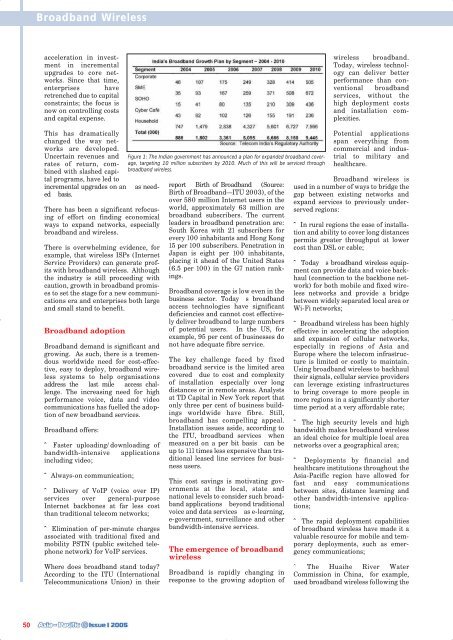Contents - Connect-World
Contents - Connect-World
Contents - Connect-World
Create successful ePaper yourself
Turn your PDF publications into a flip-book with our unique Google optimized e-Paper software.
Broadband Wireless<br />
acceleration in investment<br />
in incremental<br />
upgrades to core networks.<br />
Since that time,<br />
enterprises have<br />
retrenched due to capital<br />
constraints; the focus is<br />
now on controlling costs<br />
and capital expense.<br />
wireless broadband.<br />
Today, wireless technology<br />
can deliver better<br />
performance than conventional<br />
broadband<br />
services, without the<br />
high deployment costs<br />
and installation complexities.<br />
This has dramatically<br />
changed the way networks<br />
are developed.<br />
Uncertain revenues and<br />
rates of return, combined<br />
with slashed capital<br />
programs, have led to<br />
incremental upgrades on an as needed<br />
basis.<br />
There has been a significant refocusing<br />
of effort on finding economical<br />
ways to expand networks, especially<br />
broadband and wireless.<br />
There is overwhelming evidence, for<br />
example, that wireless ISPs (Internet<br />
Service Providers) can generate profits<br />
with broadband wireless. Although<br />
the industry is still proceeding with<br />
caution, growth in broadband promises<br />
to set the stage for a new communications<br />
era and enterprises both large<br />
and small stand to benefit.<br />
Broadband adoption<br />
Broadband demand is significant and<br />
growing. As such, there is a tremendous<br />
worldwide need for cost-effective,<br />
easy to deploy, broadband wireless<br />
systems to help organisations<br />
address the last mile access challenge.<br />
The increasing need for high<br />
performance voice, data and video<br />
communications has fuelled the adoption<br />
of new broadband services.<br />
Broadband offers:<br />
ˆ Faster uploading/downloading of<br />
bandwidth-intensive applications<br />
including video;<br />
ˆ Always-on communication;<br />
ˆ Delivery of VoIP (voice over IP)<br />
services over general-purpose<br />
Internet backbones at far less cost<br />
than traditional telecom networks;<br />
ˆ Elimination of per-minute charges<br />
associated with traditional fixed and<br />
mobility PSTN (public switched telephone<br />
network) for VoIP services.<br />
Where does broadband stand today<br />
According to the ITU (International<br />
Telecommunications Union) in their<br />
Figure 1: The Indian government has announced a plan for expanded broadband coverage,<br />
targeting 10 million subscribers by 2010. Much of this will be serviced through<br />
broadband wireless.<br />
report Birth of Broadband (Source:<br />
Birth of Broadband—ITU 2003), of the<br />
over 580 million Internet users in the<br />
world, approximately 63 million are<br />
broadband subscribers. The current<br />
leaders in broadband penetration are:<br />
South Korea with 21 subscribers for<br />
every 100 inhabitants and Hong Kong<br />
15 per 100 subscribers. Penetration in<br />
Japan is eight per 100 inhabitants,<br />
placing it ahead of the United States<br />
(6.5 per 100) in the G7 nation rankings.<br />
Broadband coverage is low even in the<br />
business sector. Todays broadband<br />
access technologies have significant<br />
deficiencies and cannot cost effectively<br />
deliver broadband to large numbers<br />
of potential users. In the US, for<br />
example, 95 per cent of businesses do<br />
not have adequate fibre service.<br />
The key challenge faced by fixed<br />
broadband service is the limited area<br />
covereddue to cost and complexity<br />
of installationespecially over long<br />
distances or in remote areas. Analysts<br />
at TD Capital in New York report that<br />
only three per cent of business buildings<br />
worldwide have fibre. Still,<br />
broadband has compelling appeal.<br />
Installation issues aside, according to<br />
the ITU, broadband serviceswhen<br />
measured on a per bit basiscan be<br />
up to 111 times less expensive than traditional<br />
leased line services for business<br />
users.<br />
This cost savings is motivating governments<br />
at the local, state and<br />
national levels to consider such broadband<br />
applicationsbeyond traditional<br />
voice and data servicesas e-learning,<br />
e-government, surveillance and other<br />
bandwidth-intensive services.<br />
The emergence of broadband<br />
wireless<br />
Broadband is rapidly changing in<br />
response to the growing adoption of<br />
Potential applications<br />
span everything from<br />
commercial and industrial<br />
to military and<br />
healthcare.<br />
Broadband wireless is<br />
used in a number of ways to bridge the<br />
gap between existing networks and<br />
expand services to previously underserved<br />
regions:<br />
ˆ In rural regions the ease of installation<br />
and ability to cover long distances<br />
permits greater throughput at lower<br />
cost than DSL or cable;<br />
ˆ Todays broadband wireless equipment<br />
can provide data and voice backhaul<br />
(connection to the backbone network)<br />
for both mobile and fixed wireless<br />
networks and provide a bridge<br />
between widely separated local area or<br />
Wi-Fi networks;<br />
ˆ Broadband wireless has been highly<br />
effective in accelerating the adoption<br />
and expansion of cellular networks,<br />
especially in regions of Asia and<br />
Europe where the telecom infrastructure<br />
is limited or costly to maintain.<br />
Using broadband wireless to backhaul<br />
their signals, cellular service providers<br />
can leverage existing infrastructures<br />
to bring coverage to more people in<br />
more regions in a significantly shorter<br />
time period at a very affordable rate;<br />
ˆ The high security levels and high<br />
bandwidth makes broadband wireless<br />
an ideal choice for multiple local area<br />
networks over a geographical area;<br />
ˆ Deployments by financial and<br />
healthcare institutions throughout the<br />
Asia-Pacific region have allowed for<br />
fast and easy communications<br />
between sites, distance learning and<br />
other bandwidth-intensive applications;<br />
ˆ The rapid deployment capabilities<br />
of broadband wireless have made it a<br />
valuable resource for mobile and temporary<br />
deployments, such as emergency<br />
communications;<br />
ˆ The Huaihe River Water<br />
Commission in China, for example,<br />
used broadband wireless following the<br />
50
















